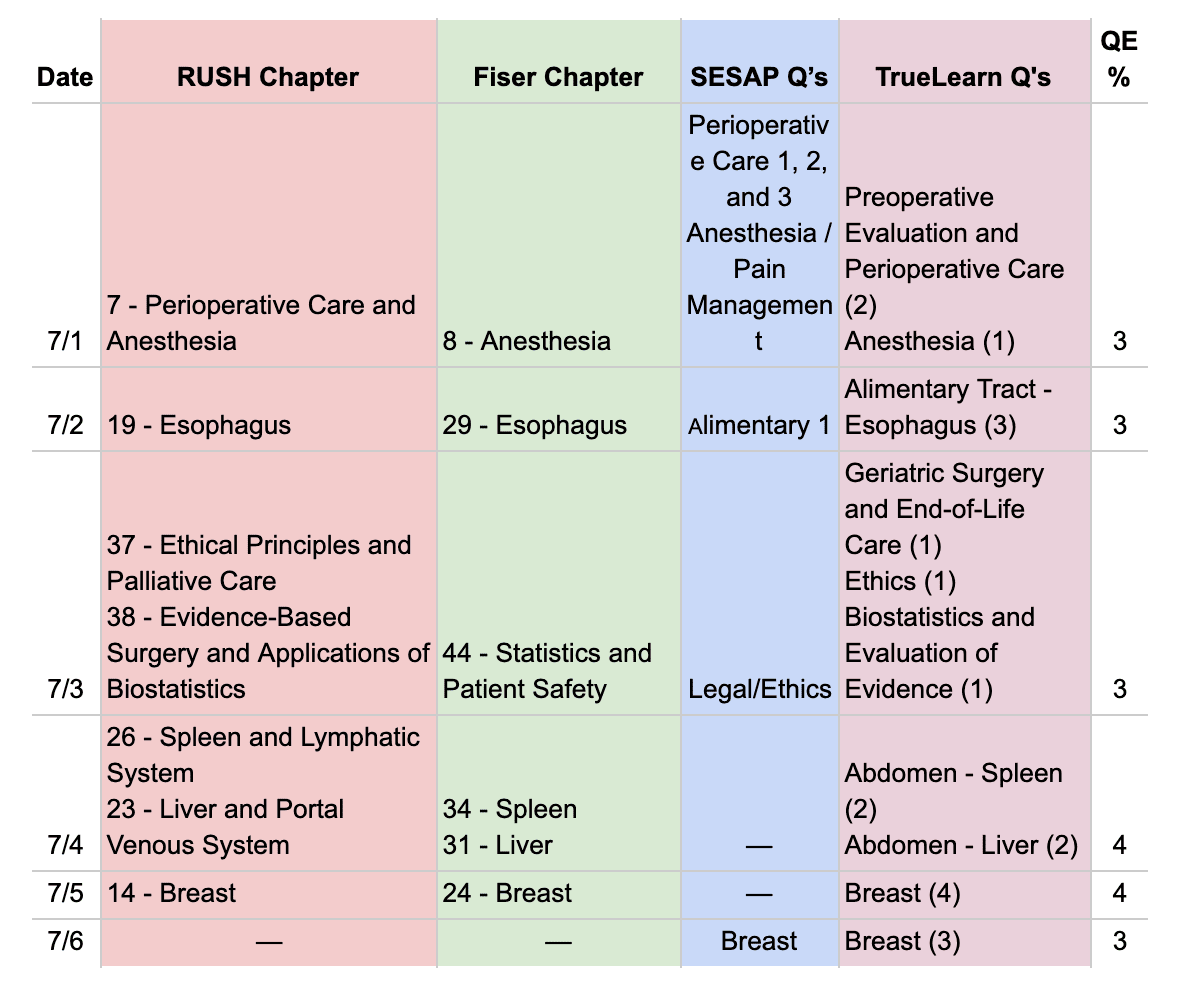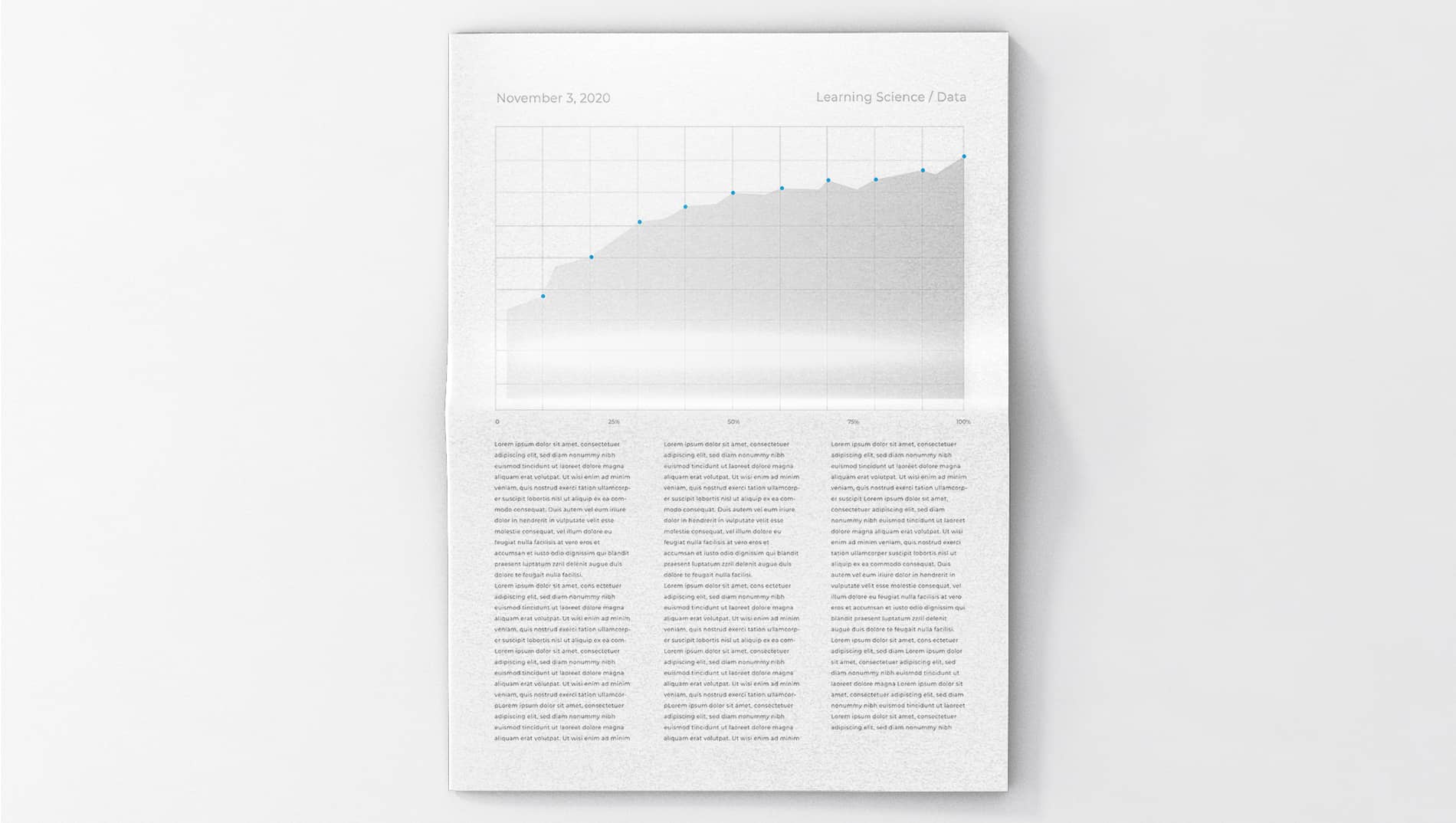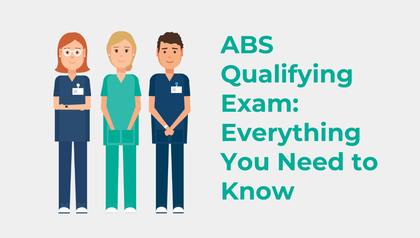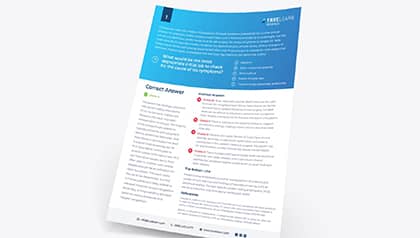How to Study for the ABS Qualifying Test
Every trainee will have to sit for the ABS Qualifying Exam (QE) at some point.
Unlike the ABSITE, where percentile matters for a desirable fellowship match, the emphasis on the QE tends to be on simply passing. The passing score is not absolute, but based on recent administrations, usually 90% or more of diplomates pass on their first attempt.
The key to a solid performance is comprehensive coverage of the topics you may see on the exam. Some people may see “high yield” questions during the years they take the ABSITE, but the QE consists of an entirely different set of questions. Time management can be an issue given the busy lifestyles of trainees, so a smart study plan is key to spending what little time is available effectively. While easier said than done, with a little forethought, this approach is doable. Below are some steps to consider before setting out on studying for the ABS Qualifying test.
1. Review the ABS QE Question Guide
Before venturing out to prepare for the exam, review the guidelines that the ABS uses in making the questions. The guide contains useful information regarding exam design. Each answer choice is picked so that it could be correct if the vignette were changed slightly; thus, it’s a good idea to spend time not only on understanding why an answer is correct but also what it would take to make the wrong answers correct.
2. Set a Content-based Study Plan and Stick to It
A study schedule is the backbone to written exam success because the exams cover an exceptional breadth of material that you may not even see during your training, such as surgery of the hand, burns, or even trauma if you didn’t train at a trauma hospital. Residents are often busy and time is a precious resource. One way to organize a study schedule is to allot time based on an exam’s content outline (ie, a content-based study plan).
The ABS publishes a content outline for the QE. This outline identifies the breakdown of questions you’ll encounter on any given exam. Using the QE content outline as an example, a content-based study plan would intentionally devote more time to more heavily represented topics such as Alimentary Tract (15%), Abdomen (12%), Trauma (8%), and Vascular (7%).
One advantage of using content-based study plans is that popular resources such as a general surgery board review qbank, The ABSITE Review (Fiser), Rush University Medical Center Review of Surgery (RUSH), and Surgical Education and Self-Assessment Program (SESAP) are actually already organized into sections that mirror the content outline and can be readily included. Another advantage is that, even if you miss a day, you can simply move on because your overall study plan has already been optimized for what time you have based on how likely you are to encounter the topic on the exam.
As an example, if you spend 50 days studying, each day will cover 2% of the exam content outline, so a missed day is just 2% of the exam’s content. If you choose not to synchronize your study plan this way and, say, plan to devote a day to each topic equally, then missing the “abdomen day” translates to missing a whopping 12% of the QE. How many days you want to spend studying is up to you. Many residents will allot 2 months for dedicated preparation.
An excerpt of a content-based study plan for the QE may look like this:

In this example, the time spent covering topics from Fiser, RUSH, SESAP, and TrueLearn mirrors the QE content to cover about 3-4% of the exam each day when possible. Breast is divided into two parts as it represents 7% of the QE content, allowing more study time to be spent on this more represented topic. Regardless of how many Breast questions appear on TrueLearn, about 50% of them are answered on each of the two allotted days, so that each day you continue to cover somewhere between 3-4% of the QE content outline overall.
TrueLearn allows users to filter question sets by category, so the numbers in parentheses for each “TrueLean Q’s” category represent how much those questions contribute to the “QE %” total, based on the QE content outline. TrueLearn’s content distribution approximately matches the exam by category percentage.
Sometimes, the “QE %” breakdown isn’t perfect. Preoperative Evaluation and Perioperative Care is explicitly mentioned as 2% on the QE content outline, but what about Anesthesia? Anesthesia is 1 of 6 categories under “Miscellaneous Topics,” which represent 5% of the exam, making it approximately 1% of the exam overall. Aiming for a goal of 3-4% per day, Anesthesia is lumped together with Pre/Periop.
Miss a day? No problem: Weekends are generally scheduled as “downtime” and can act either as off days or to catch-up days. Of course, the schedule should be tailored to whatever resources you feel work best for you.
Done correctly, the process will feel something like a “Tetris” puzzle, with you mixing and matching sections to ensure evenly spaced chunks under the “QE %” column that collectively add up to 100%.
3. Use a Variety of Resources
Everyone will find that certain resources just work better, and that’s fine. But you should try to use a broad range of resources and possibly vary that throughout your training.
The testing effect describes a phenomenon in which taking test questions in and of itself increases learning, and in this way the questions do not merely assess your knowledge but improve it. As such, any study plan should incorporate at least some test questions as routine. TrueLearn’s ABS QE SmartBank is a well-known, popular testing bank offering questions over a broad variety of topics that can be filtered out to cater to your study plans. It offers metrics the other resources do not, such as performance analysis and feedback about how you compare to others using this resource.
RUSH is great for content review, but a lot of its material won’t appear on the exam nor do the exam questions follow its formatting guidelines. Fiser is frequently touted as the “bible” for the written board exams. However, Fiser should not be used alone because it is quite concise and intentionally avoids longer explanations that contextualize the material presented to achieve its purpose of being a concise review guide.
SESAP is a question bank put together by a multidisciplinary panel of experts. While questions on SESAP will not be duplicated verbatim on the board exam, the topics may be similar, so spending time reviewing the material presented there may be worthwhile. Note that some questions on SESAP involve matching, but you won’t see matching questions on the QE.
Other resources, such as the ACS Surgery: Principles and Practice textbook, provide excellent visuals to help answer questions regarding operative steps and “How do I expose this structure during an operation?” questions. The NCCN (National Comprehensive Cancer Network) Guidelines provide free up-to-date guidelines on the management of a wide variety of oncologic conditions the general surgeon can encounter. UpToDate is another excellent resource, with current information on most topics you may encounter on the QE that can be easily referenced on an as-needed basis.
Knowing how many resources to include in a single study plan is likely going to be a process of trial and error, at least at first, until you get a sense of how much material you can cover on average. If you are a more junior resident not taking the QE, you may want to try this method for the ABSITE instead to get a sense of how fast you cover material without skipping too much.
4. Study Each Topic
Board exams are wide in their breadth. Make every effort to ensure you’ve “gone to the zoo,” so to speak, and seen all the “zebra” topics that may show up in the daily life of a general surgeon. Each question is equally weighted, so if you get a difficult abdominal question wrong but an easier hand question right, you break even with someone who incorrectly answers the uncommonly encountered hand question but correctly answers the more common abdominal question.
5. Do Lots of Practice Questions
Doing lots of practice questions not only helps you identify weak areas but also improves your stamina for the actual exam. Remember, the exam is 300 questions spread over an 8-hour period, so you should practice long question sets throughout and try to stay focused. Especially as you get closer to test time, consider mixing questions from multiple categories in timed mode to better simulate the exam experience.
6. Put Extra Time in Your Study Schedule so You Aren’t Rushed
In the week or so before the exam, try to allot some time to catch up on missed days, retake any questions you got wrong to ensure you’ve learned from your mistakes, and do a “final pass” over any notes you made along the way. Avoid adding new material in the days immediately preceding the exam and instead focus on reviewing what you learned so it is fresh in your mind.
7. Stay Relaxed and Focused
The exam can be stressful, but know that if you put the effort into an efficient study method, you will be in great standing come the exam. Remember, there are no “trick questions” on the exam, so don’t overthink things. Try to answer the question before reviewing the choices, as doing so will often get you the right answer. Also, try to get a good night’s rest before the exam so that your concentration is at its best.
The questions are generally straightforward and the correct answer should be spotted from a “mile away.” That said, be sure to read the question carefully and understand exactly what is being asked. Getting a question wrong from a simple oversight is a suboptimal outcome after all the effort you put into a good study plan! You can always mark a question and go back, and you should do so.
Bringing a snack or beverage may give you the energy you need to stay focused, but if you are not a caffeine drinker at baseline, try not to consume a lot of caffeine on the exam day as it may make you jittery and affect your concentration negatively.
After the ABS Qualifying Test: Take Notes
Probably the last thing on your mind after taking such a long exam is making notes of topics you weren’t sure about for later review, but you should try to spend some time doing so anyways. Doing so can help you strengthen your areas of weakness and can be helpful when reviewing your score report, on which incorrectly answered questions will be given to you as general topics for review, just as was the case for the ABSITE. You can also look for a similar question you may have encountered while studying and compare it with what you remember from the exam to gain more context and a deeper understanding of the topic.
The exam is supposed to test your knowledge, but if you do this last step, you can also use the exam to improve your knowledge as well and become a better overall surgeon. It goes without saying, but never share your own private internal “debrief” notes with anyone as that constitutes cheating, plain and simple.
Good luck!
The author would like to acknowledge and to thank Ben Shragge for his contributions to this post.


